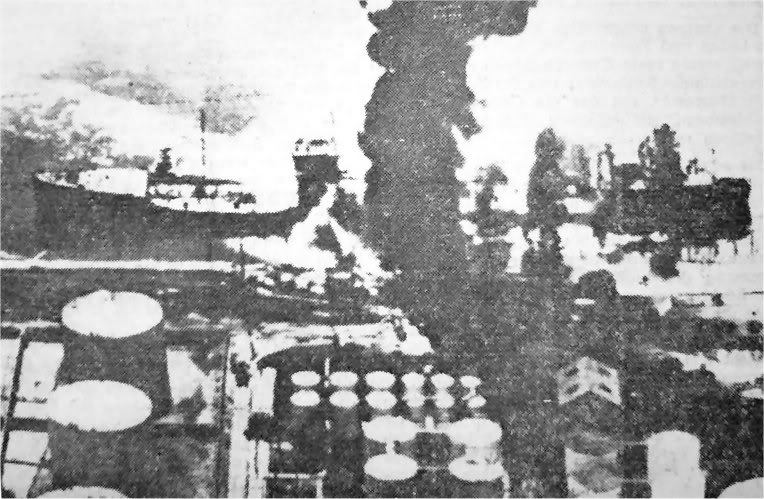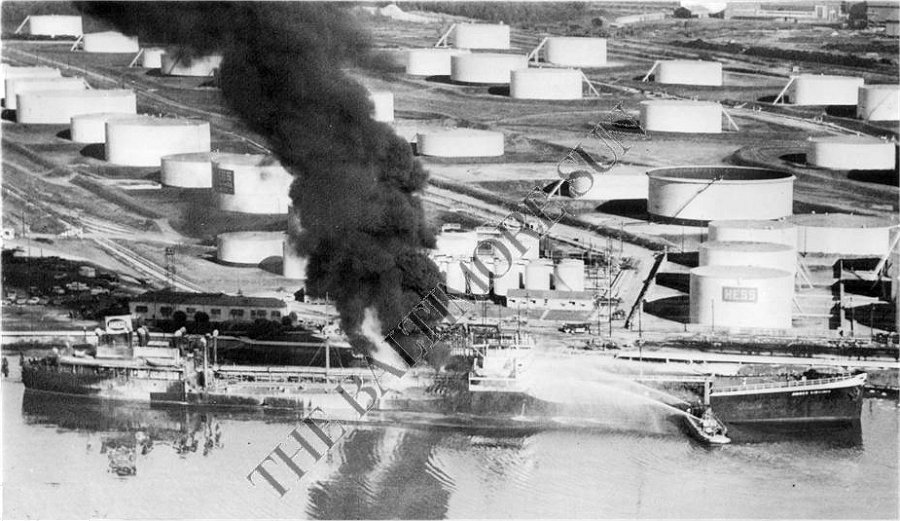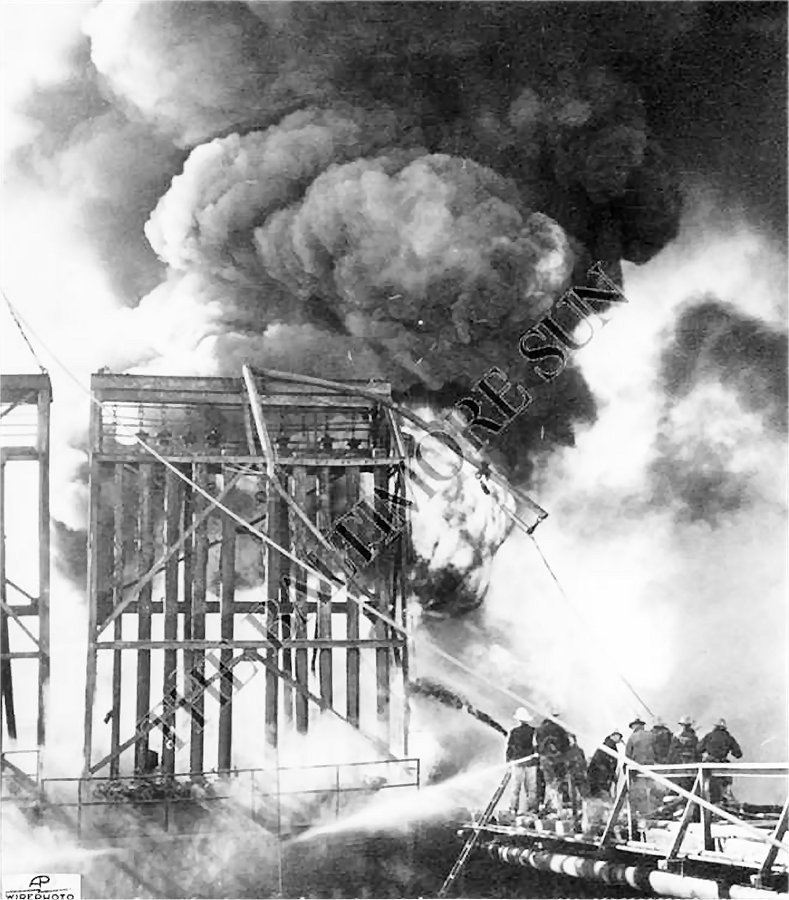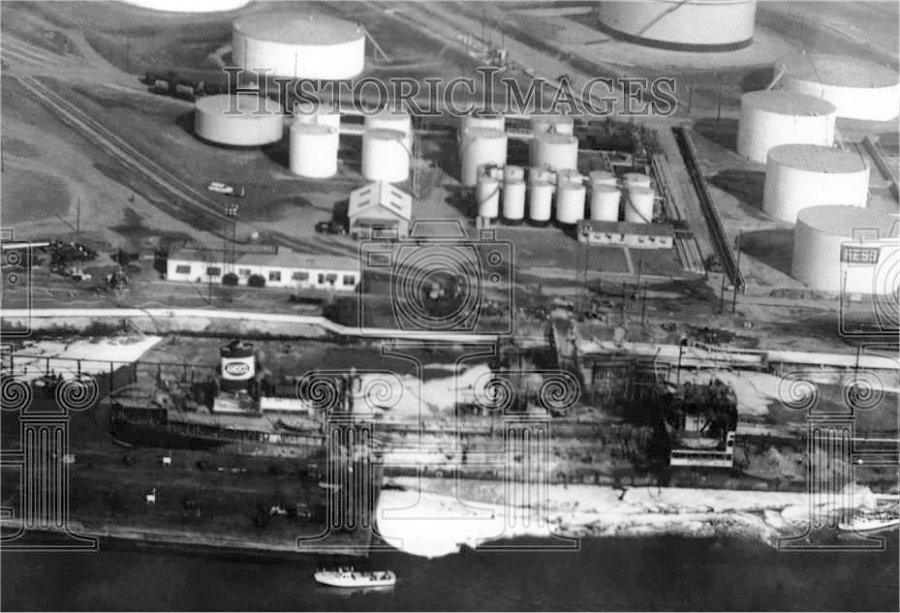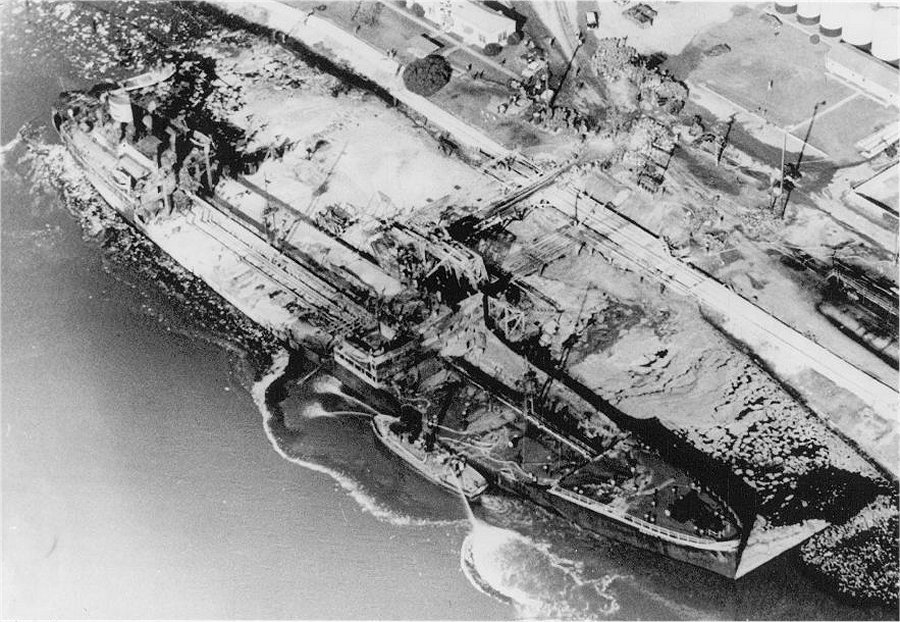Auke Visser's Famous T - Tankers Pages | home
More photos Tanker Amoco Viginia Ablaze
Not very good picture of the "Amoco Virginia" (ex. "Hat Creek"), burning in Houston,
TX on Sunday, November 8th, 1959.
"Amoco Virginia" (ex. "Hat Creek"), burning in Houston, TX on Sunday, November 8th, 1959.
( AP Wire photo )
"Amoco Virginia" (ex. "Hat Creek"), burning in Houston, TX on Sunday, November 8th, 1959.
( AP Wire photo )
"Amoco Virginia" (ex. "Hat Creek"), burning in Houston, TX on Sunday, November 8th, 1959.
Text with photo :
Houston, Barge at left pumps remaining gasoline and oil from burned-out tanker Amoco Virginia November 11th. Officials said danger of another fire or explosion would remain untill all the fuel was removed from the stricken tanker. Fireman and Coast Guard keep poole of foamite surrounding the ship to lessen fire hazard.
( UPI Telephoto )
|
"Amoco Virginia" (ex. "Hat Creek"), in Houston, TX on Sunday, after the fire, November 9th, 1959.
Text with photo :
Houston, Tx, November 9
FIRE WRECK
The tanker Amoco Virginia aground at the loading dock here today lays a fire wreck after fire and several explosions raged through it yesterday. The tanker, its sides leaking oil and gasoline, covered with a chemical foam used to put out the desastrous fire lays in its oilly grave as a fireboat sprays the ship channel around the tanker to keep gasoline pockets from forming.
( AP Wirephoto )
|
Report on the Fire onboard the "AMOCO VIRGINIA"
The S.S. AMOCO VIRGINIA was a steel hulled tank vessel of about 12,527 gross tons, approximately 571 feet in length owned by the American Oil Company. Just after midnight on Sunday, November 8, 1959 she was moored to the dock of the Hess Terminal Corporation, in the Houston Ship Channel near Galena Park, Texas. In this berth she was loading a cargo of gasoline and heating oil. She was almost fully laden with more than six million gallons of this cargo, when a fire ignited on the surface of the water in the vicinity of her berth. The flames quickly spread surrounding the vessel and some of her barges moored alongside. One of her barges exploded, propelling flaming gasoline onto the vessel.
Explosions followed in some of her cargo tanks. Fire spread over other portions of the ship, igniting portions of her cargo, and flames licked as high as her masts. Those on board the vessel were unable to fight the fire with her firefighting systems.
Several crew members were killed. The vessel and her cargo lay burning out of control with grave danger of explosion.
The adjacent docks stood threatened with a major disaster. The Houston Ship Channel was ordered closed by the U.S.
Coast Guard. Fire departments from the City of Houston and eighteen other municipalities joined in the fight to stop the fire along with a fireboat from the Houston Navigation District, three Coast Guard picket boats assigned to the Captain of the Port, Coast Guard personnel and equipment from the Captain of the Port, and fire parties from a Coast Guard Base and from various Coast Guard vessels in Galveston, Texas, and Sabine Pass. As morning arrived, the fire fighting had exhausted the chemical foam required to extinguish a fuel fire of this sort. The foamite supply used up to his time had come from the Coast Guard, Hess Terminal Corporation, the Houston Fire Department, the Houston Navigation District, and private industries along this area of the Houston Ship Channel. Now it was seven o'clock in the morning and the fire was almost under control. All of the chemical foam needed to fight this fuel fire was gone. Suddenly, the fire built up again, regained in power, and surpassed the intensity of the conflagration that the firefighters had conquered during the dark and dawning morning hours. A series of explosions occurred, and a new major firefighting effort was demanded. But there was no chemical foam left. The firefighters had no weapons with which to fight.
However, foam to fight was on its way. At about 7:00 A.M. the U.S. Air Force at Ellington Air Force Base sent ten 55-gallon drums of foam to the scene and another ten barrels at 9:30 A.M. The Coast Guard Houston Port Captain, with approval from the Eighth Coast Guard District office in New Orleans, bought more chemical foam from commercial sources. A veritable air lift was begun to bring foam into Houston through Ellington Air Force Base with the first plane in the airlift arriving at Ellington at 11:59 A.M. Later that afternoon Air Force and Navy aircraft arrived with foam at almost ten minute intervals. This foam air lift continued for seven hours, stopping at about 7:00 P.M. when the Houston Civil Defense spokesman advised no further need for foam. The fire had been brought for the second--but final-- time under control. This foam air lift consisted of 47 flights, hauled more than a half million pounds of foam, involved more than 400 Air Force and Navy personnel, and used some 42 Air Force and Navy vehicles.
|
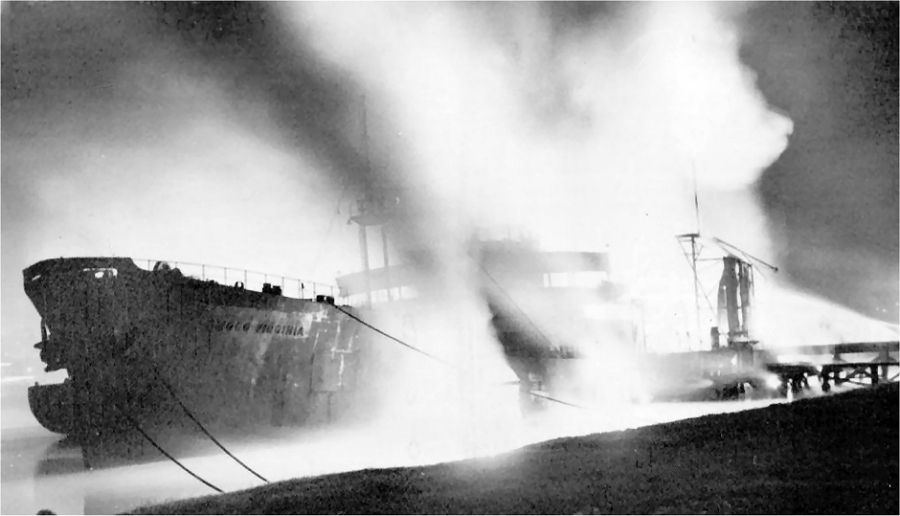
"Amoco Virginia" (ex. "Hat Creek"), in Houston, TX on Sunday, after the fire, November 9th, 1959.
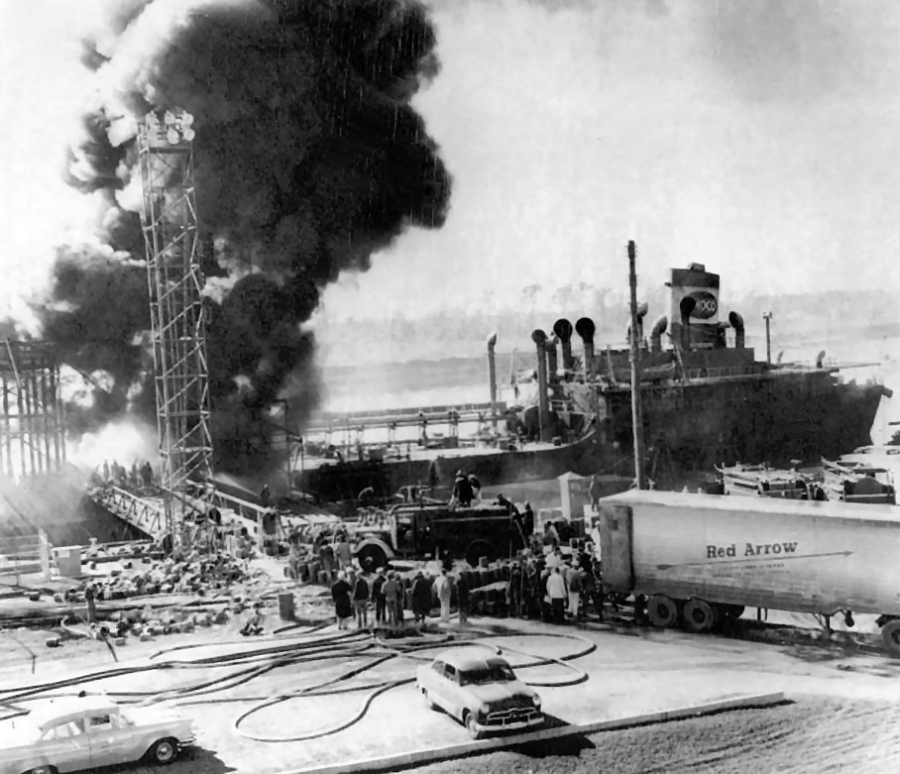
"Amoco Virginia" (ex. "Hat Creek"), in Houston, TX on Sunday, after the fire, November 9th, 1959.
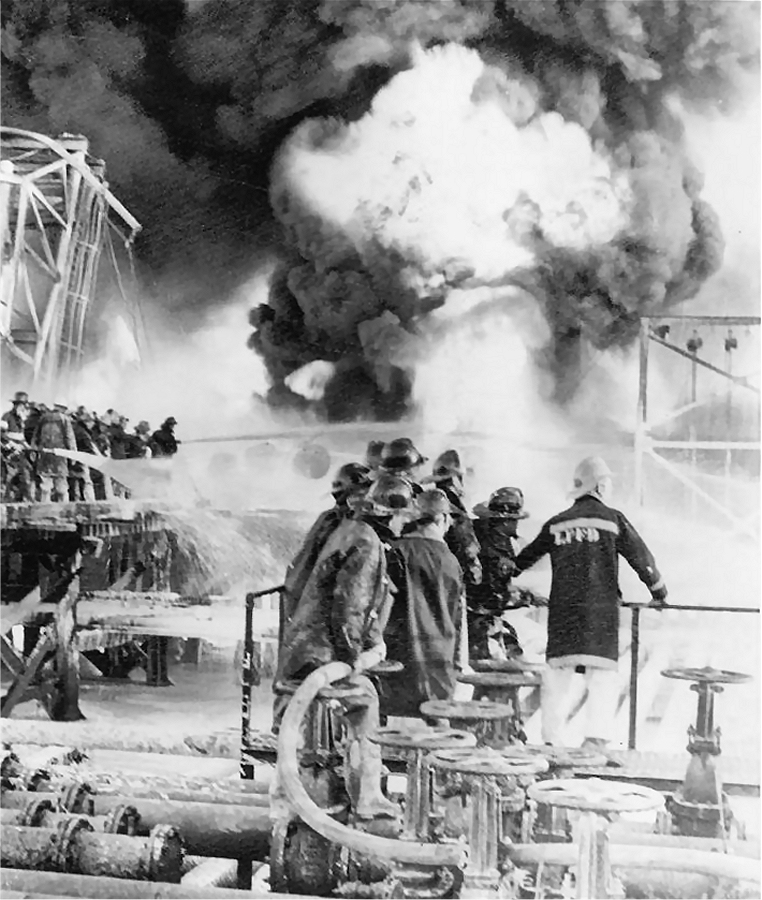
"Amoco Virginia" (ex. "Hat Creek"), in Houston, TX on Sunday, after the fire, November 9th, 1959.
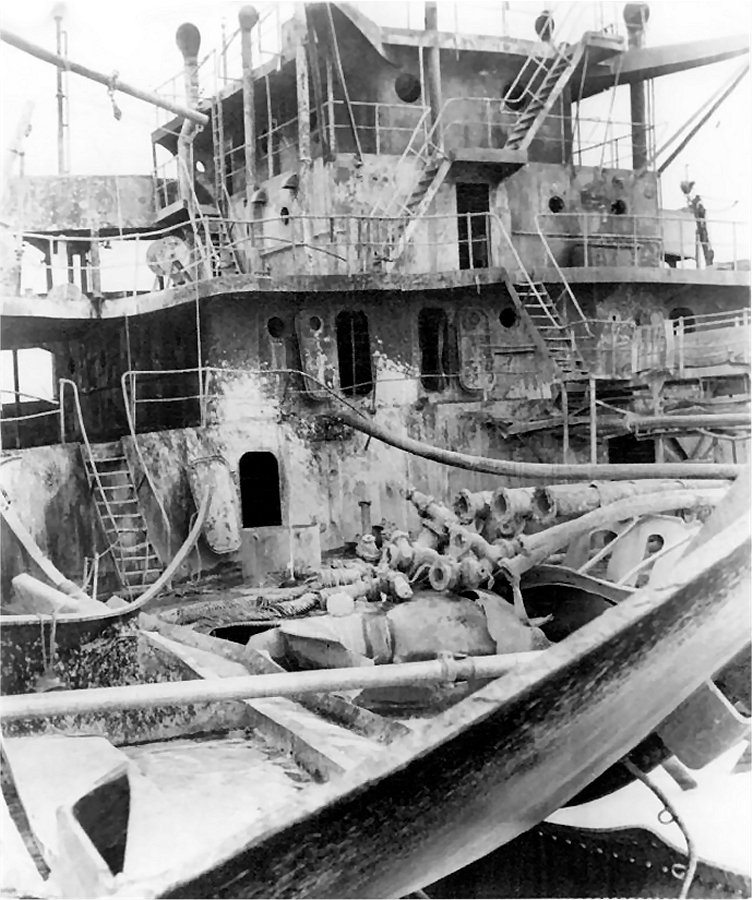
"Amoco Virginia" (ex. "Hat Creek"), in Houston, TX, the day after the fire..
